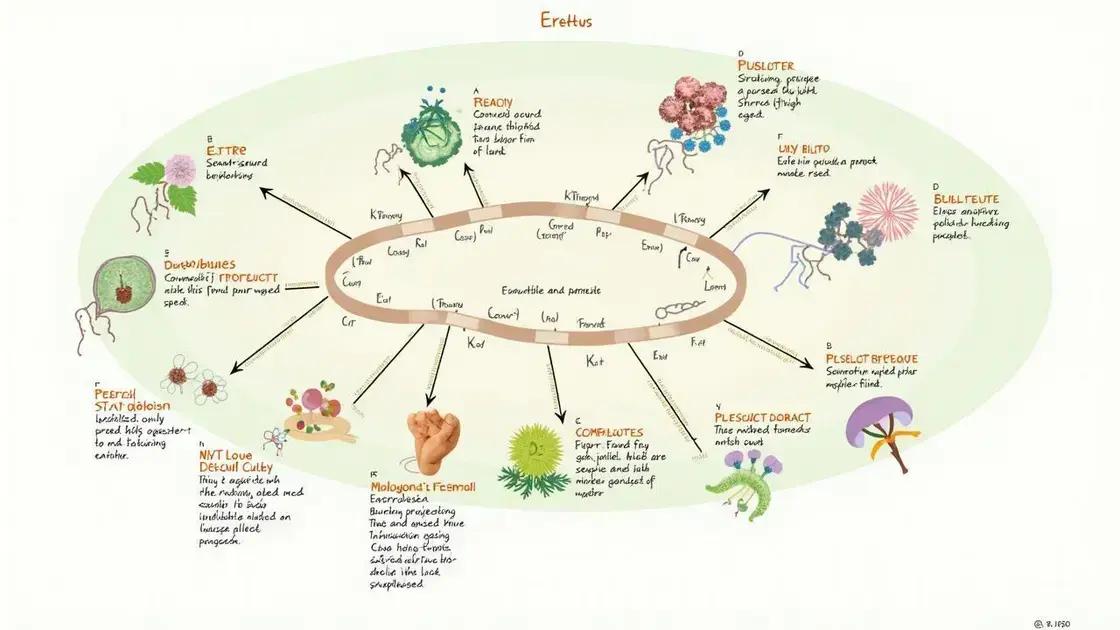The composition of Erettus includes essential elements such as carbon, hydrogen, oxygen, and nitrogen, which play significant roles in its biological and chemical properties, leading to various applications in biotechnology, medicine, and environmental science.
What is the composition of Erettus? This question invites intriguing exploration into the fundamental elements that make up this remarkable entity. Erettus is not just a scientific term; it encompasses a world of discoveries tied to its chemical makeup and various applications. In this article, we will delve into the core components, the significance of Erettus in research, and its promising future. Join us as we uncover the secrets behind Erettus and its multifaceted nature.
Understanding Erettus

Erettus is a fascinating subject that captures the interest of scientists and researchers alike. Understanding Erettus begins with comprehending its core components. Erettus can refer to various contexts, including its definition in the scientific realm and its biological significance. The term might relate to specific organisms or chemical compounds, depending on the field of study.
The Scientific Significance
In many scientific discussions, Erettus embodies a mixture of elements crucial for certain reactions or functions. Studying its composition allows us to unveil the mysteries behind its behavior in various environments. This exploration can provide insights into ecological interactions or the biochemical processes that sustain life.
Biological Aspects of Erettus
When looking at the biological perspective, Erettus can be tied to specific species or molecular structures. Identifying what makes up Erettus helps illuminate its role within specific ecosystems or its application in biotechnology. For instance, understanding its composition may shed light on how certain organisms adapt to their surroundings.
Chemical Interactions
The chemical makeup of Erettus plays a vital role in its interactions with other substances. By analyzing these interactions, we can determine how Erettus reacts under different conditions and what implications this behavior has across various industries, from pharmaceuticals to environmental science.
As we dive deeper into the nuances of Erettus, it becomes crucial to recognize its multifaceted nature. Each component contributes significantly to understanding its overall impact, setting the stage for future exploration and application.
Chemical Makeup of Erettus

The chemical makeup of Erettus is a complex and intricate area of study. To understand it fully, we must explore the main components and their roles. Erettus primarily consists of various elements that are essential for its functions. The most common elements found in Erettus include carbon, hydrogen, oxygen, and nitrogen. These elements come together in unique ways to form compounds that define Erettus.
Elemental Composition
Carbon plays a crucial role in shaping the structure of Erettus. It forms the backbone of organic molecules, allowing for complex formations. Hydrogen bonds with carbon and other elements to create a variety of structures. Oxygen is often present, participating in chemical reactions that are vital for energy production. Lastly, nitrogen is significant in building amino acids, which are the building blocks of proteins.
Significance of Chemical Bonds
The way these elements bond together is essential. Covalent bonds create stable structures, while ionic bonds can lead to unique properties. Understanding these bonds helps clarify how Erettus interacts with its environment. The arrangement of these atoms determines physical and chemical characteristics.
Impact of pH Levels
Another factor affecting Erettus’s makeup is the pH level of its environment. pH can influence the stability of the compounds and the overall reactivity of Erettus. Acidic or basic conditions can lead to changes in structure and function. Thus, maintaining optimal pH levels is crucial for the integrity of Erettus.
Research continues to delve into the specific reactions and adaptations that Erettus undergoes in various conditions. This ongoing investigation helps scientists uncover the mysteries surrounding its chemical makeup and its relevance in different biological and environmental contexts.
Applications of Erettus

The applications of Erettus span across various fields, making it a versatile subject of study. Understanding its applications helps us appreciate its importance in both science and industry. One significant area is biotechnology, where Erettus plays a crucial role in genetic analysis and molecular biology. Scientists utilize the characteristics of Erettus to develop new methods for studying genes and proteins.
Medical Uses
In the medical field, Erettus has potential applications in developing therapeutic agents. By understanding its composition, researchers can design drugs that target specific pathways. This can lead to innovations in treating diseases and conditions that currently lack effective solutions.
Environmental Science
Moreover, Erettus is relevant to environmental science. It can be used in bioremediation, helping to clean up contaminated sites by breaking down pollutants. This capability highlights the role of Erettus in promoting sustainability and improving ecological health.
Industrial Applications
Industries also benefit from Erettus. For example, in the manufacturing sector, understanding its properties can lead to the creation of better materials. These materials might offer improved durability or efficiency in production processes, thereby enhancing overall performance.
The versatility of Erettus opens doors to numerous applications, proving its significance in advancing technology and improving health outcomes across several domains.
The Future of Erettus Research

The future of Erettus research holds promising potential that could lead to groundbreaking discoveries. As new technologies emerge, the study of Erettus is likely to evolve and expand. Researchers are focusing on understanding the molecular mechanisms of Erettus more deeply, allowing for enhanced applications in science and medicine.
Advancements in Technology
With advancements in genomic technologies and data analysis, scientists can now explore Erettus at unprecedented levels. High-throughput screening methods enable the investigation of numerous samples quickly, helping researchers identify new compounds and their functions.
Interdisciplinary Approaches
The future of Erettus research will also benefit from interdisciplinary approaches. By combining knowledge from fields like chemistry, biology, and environmental science, researchers can gain a comprehensive view of Erettus and its implications in various contexts. This collaboration may lead to innovative solutions for complex problems, such as environmental remediation or health-related challenges.
Potential Impacts
As Erettus research progresses, its impact on sectors such as agriculture and pharmaceuticals may become significant. Understanding how Erettus can enhance crop resilience or contribute to drug development could lead to sustainable practices and improved health outcomes. Researchers are optimistic that the ongoing studies will reveal new abilities and features of Erettus.
Given the current trajectory, it appears that the future of Erettus research is bright, with numerous possibilities on the horizon that may unlock further secrets about its composition and applications.
In Conclusion: The Secrets of Erettus Revealed
The exploration of Erettus has unveiled its intricate composition and multifaceted applications. From understanding its chemical makeup to discovering its significant roles in biotechnology, medicine, and environmental science, each layer of Erettus plays a crucial part in various fields.
Looking forward, the future of Erettus research is filled with potential breakthroughs, supported by advancements in technology and interdisciplinary collaboration. As we continue to unravel the secrets behind Erettus, the insights gained could lead to revolutionary changes in practices and innovations that benefit both science and society.
Endeavoring further into the realm of Erettus not only enhances our knowledge but also opens new doors for practical applications that can transform industries and improve lives.
FAQ – Frequently Asked Questions about Erettus
What is Erettus?
Erettus refers to a subject of study that can involve biological, chemical, and environmental aspects, often explored in scientific research.
Why is understanding the composition of Erettus important?
Understanding the composition of Erettus helps reveal its properties and applications, which can benefit fields like biotechnology and environmental science.
What are the main elements found in Erettus?
The main elements in Erettus typically include carbon, hydrogen, oxygen, and nitrogen, which contribute to its chemical structure and functions.
How is Erettus used in biotechnology?
In biotechnology, Erettus is used in genetic analysis and molecular biology, helping researchers develop methods for studying genes and proteins.
What potential applications does Erettus have in medicine?
Erettus has potential applications in drug development, allowing researchers to design targeted therapies for various diseases.
How does Erettus contribute to environmental science?
Erettus can aid in bioremediation, helping clean up contaminated environments by breaking down harmful pollutants.













